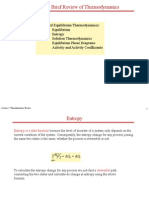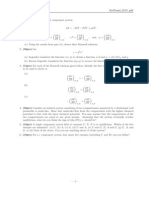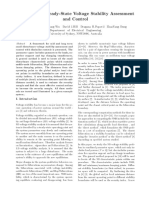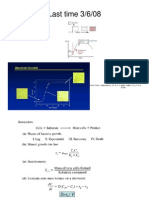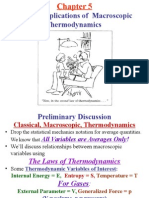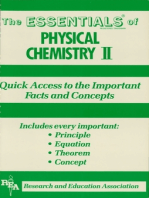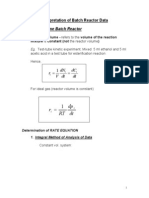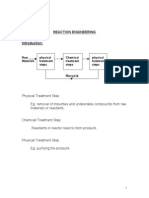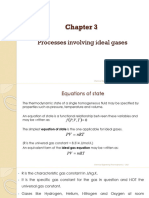Advanced Thermodynamics: Outline
Advanced Thermodynamics: Outline
Uploaded by
xx_aleksa_hrvatska_xxCopyright:
Available Formats
Advanced Thermodynamics: Outline
Advanced Thermodynamics: Outline
Uploaded by
xx_aleksa_hrvatska_xxOriginal Description:
Original Title
Copyright
Available Formats
Share this document
Did you find this document useful?
Is this content inappropriate?
Copyright:
Available Formats
Advanced Thermodynamics: Outline
Advanced Thermodynamics: Outline
Uploaded by
xx_aleksa_hrvatska_xxCopyright:
Available Formats
1
Centre for Energy
1
Advanced Thermodynamics
Thermodynamic Potentials & Equilibrium
Lecture 3, 26
th
February 2014
Advanced Thermodynamics
Centre for Energy
2
Outline
1. The Thermodynamic Potentials
2. Equilibrium Criteria from the Potentials
3. Open Systems & The Chemical Potential
4. Phase Equilibrium Requirements
Text References:
Kyle, Chapters 4.6, 5.1-5.3, 7.1-7.3, 9.3-9.6
Prausnitz, Chapter 2.1-2.8
different sign convention for W
2
Advanced Thermodynamics
Centre for Energy
3
The Thermodynamic Potentials
Four functions that each contain all the
thermodynamic information about a system:
Each contains same information, but in different
forms choose the one thats convenient
U Internal Energy
PV U H + Enthalpy
TS U A Helmholtz Energy
TS H G Gibbs Energy
Also known as
free energies or
work functions
(symbol F sometimes used)
Advanced Thermodynamics
Centre for Energy
4
The Thermodynamic Potentials
Only changes in the potentials are knowable
unless you have a microscopic model
In practice, datum or reference states are defined
Fundamental EOS model the potentials directly
contain calorific and volumetric properties
U
H A
G
TS
TS
PV
PV
3
Advanced Thermodynamics
Centre for Energy
5
Independent Variables
Consider the form of the Fundamental Equation
This implies that: (1) S & V are the independent variables
for U and (2) T & P are the first partial derivatives of U
We can consider U for a system at equilibrium
as a surface and its thermodynamic properties
as the slopes, curvatures, etc. of that surface
PdV TdS dU =
dV
V
U
dS
S
U
dU
S V
|
.
|
\
|
c
c
+
|
.
|
\
|
c
c
=
) , ( V S U U =
V
S
U
T
|
.
|
\
|
c
c
=
S
V
U
P
|
.
|
\
|
c
c
=
Advanced Thermodynamics
Centre for Energy
6
Changing Potentials & Variables
Differentiate the defining equations for H, A, G:
VdP TdS dH + =
) , ( P S H H =
SdT PdV dA =
) , ( V T A A =
SdT VdP dG = ) , ( P T G G =
Potential choice based on convenient variables
T, P & V easiest to measure G, A used often
Thermodynamic network of partial derivatives
T
C
T
H
T T
S
T
G
P
P P
P
= |
.
|
\
|
c
c
= |
.
|
\
|
c
c
=
|
|
.
|
\
|
c
c 1
2
2
V T
T
P
V
S
|
.
|
\
|
c
c
= |
.
|
\
|
c
c
Maxwell relation
4
Advanced Thermodynamics
Centre for Energy
7
Potentials & Equilibrium
For a process at constant S & V:
These equations characterise what equilibrium is!
They establish requirements for phase equilibria & stability
0
,
s
V S
dU 0
,
=
V S
dU
At Equilibrium
Similarly:
0
,
s
P S
dH 0
,
=
P S
dH
0
,
s
V T
dA 0
,
=
V T
dA
0
,
s
P T
dG 0
,
=
P T
dG
An equilibrium
state is a local
minimum of the
potential along
a specified path
Advanced Thermodynamics
Centre for Energy
8
Equilibrium Requirements
Consider 2 parts, o & |, of an isolated system
|
o
isolated system
No heat
transfer
No work
done
const. S
const. V
0
,
=
V S
dU At equilibrium:
0
) ( ) ( ) ( ) ( ) ( ) ( ) ( ) (
= + =
| | | | o o o o
dV P dS T dV P dS T dU
0
) ( ) (
= +
| o
dS dS 0
) ( ) (
= +
| o
dV dV
Eliminating dS
(|)
& dV
(|)
:
0 ) (
) (
) ( ) ( ) (
) ( ) ( ) (
=
=
o | o
o | o
dV P P
dS T T dU
) ( ) (
) ( ) (
| o
| o
P P
T T
=
=
Eqbm
requires:
5
Advanced Thermodynamics
Centre for Energy
9
Thermodynamic Potentials for Open System
Closed System
Internal Energy of a system depends on the number of
moles of each component in that system.
) , ( V S U U =
) , ( P S H H =
) , ( V T A A =
) , ( P T G G =
Open System
) ,.., , , (
1 N
n n V S U U =
) ,.., , , (
1 N
n n P S H H =
) ,.., , , (
1 N
n n V T A A =
) ,.., , , (
1 N
n n P T G G =
Vary moles
of i
th
component
Allow mass
to enter
Relations still hold for open system
Advanced Thermodynamics
Centre for Energy
10
The Chemical Potential
From Calculus, the total differential becomes
=
|
|
.
|
\
|
c
c
+
|
.
|
\
|
c
c
+
|
.
|
\
|
c
c
=
N
i
i
n V S
i n S n V
dn
n
U
dV
V
U
dS
S
U
dU
j
i i
1
, ,
, ,
i
n V
S
U
T
,
|
.
|
\
|
c
c
=
i
n S
V
U
P
,
|
.
|
\
|
c
c
=
=
+ =
N
i
i i
dn PdV TdS dU
1
Fundamental Eqn
for Open Systems
j
n V S
i
i
n
U
, ,
|
|
.
|
\
|
c
c
Extensive properties
Intensive properties
6
Advanced Thermodynamics
Centre for Energy
11
The Chemical Potential
Chemical potential can be defined in other ways
j j j j
n P T
i
n V T
i
n P S
i
n V S
i
i
n
G
n
A
n
H
n
U
, , , , , , , ,
|
|
.
|
\
|
c
c
=
|
|
.
|
\
|
c
c
=
|
|
.
|
\
|
c
c
=
|
|
.
|
\
|
c
c
=
Partial
molar
Gibbs
Energy
=
+ + =
N
i
i i
dn VdP TdS dH
1
=
+ =
N
i
i i
dn PdV SdT dA
1
=
+ + =
N
i
i i
dn VdP SdT dG
1
Advanced Thermodynamics
Centre for Energy
12
Closed Heterogeneous System
Consider 2 phases, o & |, in an isolated, 1 component
system. Treat each phase as an open system
|
(open system)
o
(open system)
1 component
isolated system
0
,
=
V S
dU
At equilibrium:
) ( ) ( ) ( ) ( ) ( ) ( ) ( o o o o o o o
dn dV P dS T dU + =
) ( ) ( ) ( ) ( ) ( ) ( ) ( | | | | | | |
dn dV P dS T dU + =
0
) ( ) (
= +
| o
dS dS
0
) ( ) (
= +
| o
dV dV
Extensive quantities
conserved
0
) ( ) (
= +
| o
dn dn
Eliminating dS
(|)
, dV
(|)
& dn
(|)
0 ) ( ) (
) (
) ( ) ( ) ( ) ( ) ( ) (
) ( ) ( ) (
= +
=
o | o o | o
o | o
dn dV P P
dS T T dU
0
) ( ) (
= +
| o
dU dU
mass transfer
7
Advanced Thermodynamics
Centre for Energy
13
Phase Equilibrium Requirements
1 component, 2 phase system:
vapour
(open system)
liquid
(open system)
N component
isolated system
mass transfer
) ( ) ( | o
T T =
Eqbm requires:
) ( ) ( | o
P P =
) ( ) ( | o
=
N component, vapour-liquid system:
The extra N
equations needed to
solve the standard
flash problem
Eqbm requires:
) ( ) ( V L
T T =
) ( ) ( V L
P P =
) (
1
) (
1
V L
=
) ( ) ( V
i
L
i
=
) ( ) ( V
N
L
N
=
Eqns for an N component, H -phase system?
Advanced Thermodynamics
Centre for Energy
14
Lecture 3: Core Ideas
1. The Thermodynamic Potentials: U, H, A, G
ALL the information about a system convenience
2. Equilibrium Criteria from the Potentials
0
,
=
P T
dG
0
,
=
V S
dU
0
,
=
V T
dA 0
,
=
P S
dH
4. Phase Equilibrium Requirements
N new equations:
) ( ) ( V
i
L
i
=
) ,.., , , (
1 N
n n P T G G =
j
n P T
i
i
n
G
, ,
|
|
.
|
\
|
c
c
=
3. Open Systems and the Chemical Potential
You might also like
- Lecutre 2: Brief Review of ThermodynamicsNo ratings yetLecutre 2: Brief Review of Thermodynamics15 pages
- Termodinamica de Hidrocarburos: Generalized Phase EquilibriaNo ratings yetTermodinamica de Hidrocarburos: Generalized Phase Equilibria109 pages
- Boles Lecture Notes Thermodynamics Chapter 450% (2)Boles Lecture Notes Thermodynamics Chapter 458 pages
- Prof. Dr. Ramli Ibrahim Dr. Norlaili Abu BakarNo ratings yetProf. Dr. Ramli Ibrahim Dr. Norlaili Abu Bakar24 pages
- Robust Nonlinear Controller Design of Wind Turbine With Doubly Fed Induction Generator by Using Hamiltonian Energy ApproachNo ratings yetRobust Nonlinear Controller Design of Wind Turbine With Doubly Fed Induction Generator by Using Hamiltonian Energy Approach6 pages
- School of Physics and Astronomy: Equilibrium and The Thermodynamic PotentialsNo ratings yetSchool of Physics and Astronomy: Equilibrium and The Thermodynamic Potentials4 pages
- (1+2) Introduction and Partial PropertiesNo ratings yet(1+2) Introduction and Partial Properties35 pages
- Fault Detection Based On Observer For Nonlinear Dynamic Power SystemNo ratings yetFault Detection Based On Observer For Nonlinear Dynamic Power System8 pages
- Introduction To The Characteristics of Partial Differential Equations Pertinent To Simulation of Engineering ProblemsNo ratings yetIntroduction To The Characteristics of Partial Differential Equations Pertinent To Simulation of Engineering Problems35 pages
- Passivity Based Modelling and Simulation of A Nonlinear Process Control SystemNo ratings yetPassivity Based Modelling and Simulation of A Nonlinear Process Control System6 pages
- Power-Shaping of Reaction Systems: The CSTR Case Study: A.Favache, D.DochainNo ratings yetPower-Shaping of Reaction Systems: The CSTR Case Study: A.Favache, D.Dochain25 pages
- 1208.0177 Gouy-Stodola Theorem As A Variational Principle For Open Systems.100% (1)1208.0177 Gouy-Stodola Theorem As A Variational Principle For Open Systems.16 pages
- Delay-Dependent Robust H Control of Time-Delay Systems: M. Sun Y. JiaNo ratings yetDelay-Dependent Robust H Control of Time-Delay Systems: M. Sun Y. Jia9 pages
- Coordinated Steady State Voltage Stability Assessment and ControlNo ratings yetCoordinated Steady State Voltage Stability Assessment and Control7 pages
- Thermodynamics Review For Physical Chemistry of Macromolecules in SolutionNo ratings yetThermodynamics Review For Physical Chemistry of Macromolecules in Solution27 pages
- Introduction To The Program FULLPROF Refinement ofNo ratings yetIntroduction To The Program FULLPROF Refinement of15 pages
- Module 2 part 2 ENGINEERING THERMODYNAMICS INo ratings yetModule 2 part 2 ENGINEERING THERMODYNAMICS I7 pages
- An Adaptive Fuzzy Pid Control of Hydro-Turbine Governor: Xiao-Ying Zhang, Ming-Guang ZhangNo ratings yetAn Adaptive Fuzzy Pid Control of Hydro-Turbine Governor: Xiao-Ying Zhang, Ming-Guang Zhang5 pages
- Simple Applications of Macroscopic ThermodynamicsNo ratings yetSimple Applications of Macroscopic Thermodynamics33 pages
- V V I I: Chapter 6: Power Flow Bus Admittance MatrixNo ratings yetV V I I: Chapter 6: Power Flow Bus Admittance Matrix7 pages
- Simulation of Some Power System, Control System and Power Electronics Case Studies Using Matlab and PowerWorld SimulatorFrom EverandSimulation of Some Power System, Control System and Power Electronics Case Studies Using Matlab and PowerWorld SimulatorNo ratings yet
- Student Solutions Manual to Accompany Economic Dynamics in Discrete Time, secondeditionFrom EverandStudent Solutions Manual to Accompany Economic Dynamics in Discrete Time, secondedition4.5/5 (2)
- Chemical Reaction Kinetics: Concepts, Methods and Case StudiesFrom EverandChemical Reaction Kinetics: Concepts, Methods and Case StudiesNo ratings yet
- Method of Lines PDE Analysis in Biomedical Science and EngineeringFrom EverandMethod of Lines PDE Analysis in Biomedical Science and EngineeringNo ratings yet
- Harnessing Bistable Structural Dynamics: For Vibration Control, Energy Harvesting and SensingFrom EverandHarnessing Bistable Structural Dynamics: For Vibration Control, Energy Harvesting and SensingNo ratings yet
- An Introduction To Sustainability Applied To Projects & Project Management Raw Project Management: An Agile and Adaptable Body of KnowledgeNo ratings yetAn Introduction To Sustainability Applied To Projects & Project Management Raw Project Management: An Agile and Adaptable Body of Knowledge25 pages
- DT DP RT R: Constant-Volume Batch ReactorNo ratings yetDT DP RT R: Constant-Volume Batch Reactor20 pages
- '1812 Overture': The '1812 Overture' of Peter Tchaikovsky0% (1)'1812 Overture': The '1812 Overture' of Peter Tchaikovsky4 pages
- Power Electronics Laborat O RY - EEE338 Buck-Boost ConverterNo ratings yetPower Electronics Laborat O RY - EEE338 Buck-Boost Converter4 pages
- The Radial Diffusivity Equation Is Given by - 1No ratings yetThe Radial Diffusivity Equation Is Given by - 133 pages
- Vacuum Chamber - Small Vacuum Chamber For Degassing Manufacturer From ChennaiNo ratings yetVacuum Chamber - Small Vacuum Chamber For Degassing Manufacturer From Chennai25 pages
- Weight Per Cubic Foot, Yield, and Air Content (Gravimetric) of ConcreteNo ratings yetWeight Per Cubic Foot, Yield, and Air Content (Gravimetric) of Concrete2 pages
- 8 - Chitapon - TR Winding Buckling - Paper PDFNo ratings yet8 - Chitapon - TR Winding Buckling - Paper PDF5 pages
- High Voltage Live Work Procedures Distribution Insulated Stick 2015 05100% (1)High Voltage Live Work Procedures Distribution Insulated Stick 2015 05144 pages
- SPE 17306 Modification of The Cullender and Smith Equation For More Accurate Bottomhole Pressure Calculations in Gas WellsNo ratings yetSPE 17306 Modification of The Cullender and Smith Equation For More Accurate Bottomhole Pressure Calculations in Gas Wells10 pages
- S1-3-05 - A Love-Hate Relationship - Discrepant EventNo ratings yetS1-3-05 - A Love-Hate Relationship - Discrepant Event7 pages
- Some Material Properties of PVC Products and CompoundsNo ratings yetSome Material Properties of PVC Products and Compounds51 pages
- Termodinamica de Hidrocarburos: Generalized Phase EquilibriaTermodinamica de Hidrocarburos: Generalized Phase Equilibria
- Robust Nonlinear Controller Design of Wind Turbine With Doubly Fed Induction Generator by Using Hamiltonian Energy ApproachRobust Nonlinear Controller Design of Wind Turbine With Doubly Fed Induction Generator by Using Hamiltonian Energy Approach
- School of Physics and Astronomy: Equilibrium and The Thermodynamic PotentialsSchool of Physics and Astronomy: Equilibrium and The Thermodynamic Potentials
- Fault Detection Based On Observer For Nonlinear Dynamic Power SystemFault Detection Based On Observer For Nonlinear Dynamic Power System
- Introduction To The Characteristics of Partial Differential Equations Pertinent To Simulation of Engineering ProblemsIntroduction To The Characteristics of Partial Differential Equations Pertinent To Simulation of Engineering Problems
- Passivity Based Modelling and Simulation of A Nonlinear Process Control SystemPassivity Based Modelling and Simulation of A Nonlinear Process Control System
- Power-Shaping of Reaction Systems: The CSTR Case Study: A.Favache, D.DochainPower-Shaping of Reaction Systems: The CSTR Case Study: A.Favache, D.Dochain
- 1208.0177 Gouy-Stodola Theorem As A Variational Principle For Open Systems.1208.0177 Gouy-Stodola Theorem As A Variational Principle For Open Systems.
- Delay-Dependent Robust H Control of Time-Delay Systems: M. Sun Y. JiaDelay-Dependent Robust H Control of Time-Delay Systems: M. Sun Y. Jia
- Coordinated Steady State Voltage Stability Assessment and ControlCoordinated Steady State Voltage Stability Assessment and Control
- Thermodynamics Review For Physical Chemistry of Macromolecules in SolutionThermodynamics Review For Physical Chemistry of Macromolecules in Solution
- Introduction To The Program FULLPROF Refinement ofIntroduction To The Program FULLPROF Refinement of
- An Adaptive Fuzzy Pid Control of Hydro-Turbine Governor: Xiao-Ying Zhang, Ming-Guang ZhangAn Adaptive Fuzzy Pid Control of Hydro-Turbine Governor: Xiao-Ying Zhang, Ming-Guang Zhang
- V V I I: Chapter 6: Power Flow Bus Admittance MatrixV V I I: Chapter 6: Power Flow Bus Admittance Matrix
- Systems with Delays: Analysis, Control, and ComputationsFrom EverandSystems with Delays: Analysis, Control, and Computations
- Simulation of Some Power System, Control System and Power Electronics Case Studies Using Matlab and PowerWorld SimulatorFrom EverandSimulation of Some Power System, Control System and Power Electronics Case Studies Using Matlab and PowerWorld Simulator
- Student Solutions Manual to Accompany Economic Dynamics in Discrete Time, secondeditionFrom EverandStudent Solutions Manual to Accompany Economic Dynamics in Discrete Time, secondedition
- Chemical Reaction Kinetics: Concepts, Methods and Case StudiesFrom EverandChemical Reaction Kinetics: Concepts, Methods and Case Studies
- The Essential Guide to Internet of Things (IoT)From EverandThe Essential Guide to Internet of Things (IoT)
- Method of Lines PDE Analysis in Biomedical Science and EngineeringFrom EverandMethod of Lines PDE Analysis in Biomedical Science and Engineering
- Time-Dependent Problems and Difference MethodsFrom EverandTime-Dependent Problems and Difference Methods
- Harnessing Bistable Structural Dynamics: For Vibration Control, Energy Harvesting and SensingFrom EverandHarnessing Bistable Structural Dynamics: For Vibration Control, Energy Harvesting and Sensing
- An Introduction To Sustainability Applied To Projects & Project Management Raw Project Management: An Agile and Adaptable Body of KnowledgeAn Introduction To Sustainability Applied To Projects & Project Management Raw Project Management: An Agile and Adaptable Body of Knowledge
- '1812 Overture': The '1812 Overture' of Peter Tchaikovsky'1812 Overture': The '1812 Overture' of Peter Tchaikovsky
- Power Electronics Laborat O RY - EEE338 Buck-Boost ConverterPower Electronics Laborat O RY - EEE338 Buck-Boost Converter
- Vacuum Chamber - Small Vacuum Chamber For Degassing Manufacturer From ChennaiVacuum Chamber - Small Vacuum Chamber For Degassing Manufacturer From Chennai
- Weight Per Cubic Foot, Yield, and Air Content (Gravimetric) of ConcreteWeight Per Cubic Foot, Yield, and Air Content (Gravimetric) of Concrete
- High Voltage Live Work Procedures Distribution Insulated Stick 2015 05High Voltage Live Work Procedures Distribution Insulated Stick 2015 05
- SPE 17306 Modification of The Cullender and Smith Equation For More Accurate Bottomhole Pressure Calculations in Gas WellsSPE 17306 Modification of The Cullender and Smith Equation For More Accurate Bottomhole Pressure Calculations in Gas Wells
- S1-3-05 - A Love-Hate Relationship - Discrepant EventS1-3-05 - A Love-Hate Relationship - Discrepant Event
- Some Material Properties of PVC Products and CompoundsSome Material Properties of PVC Products and Compounds





